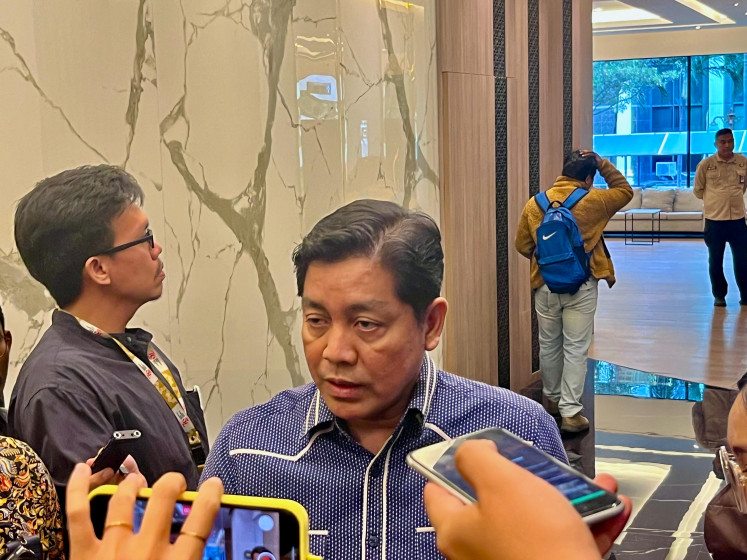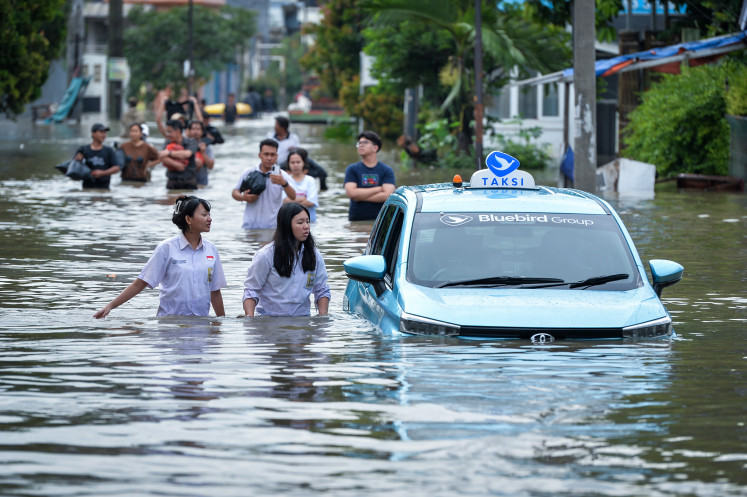Popular Reads
Top Results
Can't find what you're looking for?
View all search resultsPopular Reads
Top Results
Can't find what you're looking for?
View all search resultsKaimana designated as marine conservation area
Maritime Affairs and Fisheries Minister Freddy Numberi dedicated Kaimana regency, West Papua, as a Provincial Marine Conservation Area (KKLD) on Dec
Change text size
Gift Premium Articles
to Anyone
Maritime Affairs and Fisheries Minister Freddy Numberi dedicated Kaimana regency, West Papua, as a Provincial Marine Conservation Area (KKLD) on Dec. 11, in line with Regency Bylaw No. 4/2008.
The 597,747-hectare conservation area stretches four nautical miles from the outer-most coastline during the lowest tide, meaning it encompasses the entire marine territory of Kaimana regency.
According to Kaimana Regent Hasan Achmad, designating Kaimana a KKLD was done to preserving the area from environmental damage and to maintain its fish reserves.
"The sea is a source of livelihood for Kaimana communities, who are mostly fishermen, so it has to be preserved and developed in accordance with eco-friendly programs," he said.
Given its KKLD status, Hasan said a local bylaw would be issued to determine territorial zones.
will be a nucleus area where fishing will be banned completely, a production zone reserved for traditional fishermen and a larger zone where trawlers are not allowed to operate," Hasan said.
The KKLD, added Hasan, was also aimed at improving people's welfare, as fishermen will now be able to sell their catch to investors involved in the Kaimana fishery sector.
Kaimana's status as a KKLD was endorsed by eight native tribes. They agreed to declaring Kaimana a conservation area and handed management of the area over to the Kaimana regency administration in a ceremony held on Namatota Island, in the Triton Bay area, on April 14.
"We have handed over the sea territory to the government to designate it as a conservation area so it can be protected and preserved. Many foreign trawlers have been poaching in the area thus far and as traditional communities we have limited means to prevent them. So we hope our area can remain protected and managed carefully," Yonathan Ojanggai, chief of the Mairasi tribe said.
The regency administration has forged a cooperation deal with Conservation International, which will assist in conducting research, determining boundaries and provide training to communities on ways to preserve the environment and process marine resources in a sustainable manner.
To oversee the vast area, Minister Numberi has promised to provide speedboats for sea patrols.
Numberi expressed his gratitude to the Kaimana traditional communities for allowing their customary area to be managed by the government.
"This is a very positive matter and the only one in Indonesia in which traditional tribes have handed over their sea area to the government for supervision," Numberi said.
There is an unwritten law among native tribes in Kaimana which has been observed through the generations called sasi, or punishment. Sasi prohibits entering the sea area within a particular period and when breached, punishment can be fatal. The punishment is not meted out directly by the ruler, or kumisi, but by nature.
"Breaching the sasi means death, such as by drowning," Yonathan said.
The most common form of sasi is sasi teripang (sea cucumber) and sasi lola (clam), which are not to be caught when sasi is imposed.
The guardian of the sea during the implementation of sasi is the ruler's wife or tribal chief, who stands on the beach holding a spear overseeing the sea. Violating sasi is the considered the same as tearing the clothes off the ruler's wife or tribal chief and is thus punishable to death.
The changing times and increasing openness among the Kaimana people, as well as the increasing number of trawlers poaching within the area, are behind the communities' descision to hand over supervision and development of the area. Although sasi is still implemented, trying to manage the area with this method is no longer effective.
"Each day, large fishing boats enter Kaimana Sea. They come so close to people's settlements. What will we get if large trawlers fish all the way up to the shore?" local fisherman Muhammad Imran said.
Imran hopes that, given Kaimana's status as a KKLD, fishing boats will only operate in the open sea and will not affect the livelihood of traditional fishermen or damage the marine environment.
Based on a 2006 study conducted by Conservation International, Kaimana is home to the largest fish biomass in Southeast Asia, around 228 tons per square kilometer. It is home to 959 species of coral fish, 471 species of coral and 28 kinds of crustaceans.










